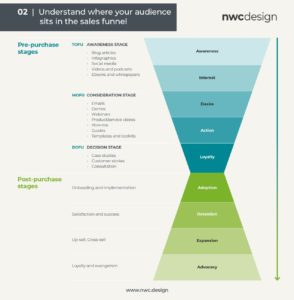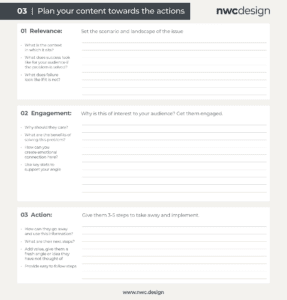It’s frustrating to start reading a piece of content marketing that you hope will reveal some inspirational ideas, only to find that it says an awful lot about nothing. What you hope will deliver valuable, actionable content turns out to do anything but.
Such content will have no unique insights, contain no subject analysis, interpret nothing and make no assessments that could help you to make the right decisions. It’s an opportunity missed to build trust and demonstrate value.
So how can you create that opportunity?
Ideally you want your audience to read and understand your content and then take some action.
Taking action comes in many forms; getting in contact, signing up to get your e-communications, sharing your content with their peers, or simply doing further research to find out more about you.
Ideally, action should also mean the audience giving some thought to their own business needs, wants and desires before you get involved. A bit of introspection plus planning goes a long way.
How to build trust by offering valuable, actionable content
The actionable content you produce will become more valuable and more trusted the more useful and effective it is. Your audience will spend more time absorbing it and be more inclined to share it with others.
Make it as easy as possible for them to start whatever action it is that you would like them to take.
Here are our four preconditions for you to ensure you are offering valuable content that drives the action and outcomes that you are seeking.
01: Know your audience
Stating the blindingly obvious should not be underestimated. You will need to know who you are speaking to and how to speak to them to achieve the best results from your content.
We’ve discussed getting to know your audience previously in our Insight blog, so we’ll not cover this in detail here. If you missed it you can access this article to learn more:
Create content that connects: REALLY get to know your audience >>>
And you can use our ‘Know your audience’ worksheet to uncover more detail about your readers:
02: Understand where your audience sits in the sales funnel
It’s worth pointing out that, yes, we know there are a plethora of conversations, articles and blogs online about the relevance of the traditional sales funnel in the digital marketing age.
While that debate continues, we are using the model because it illustrates well this part of the process.
When you know where your audience are in the sales funnel, you can better create and design content marketing that will drive them to the appropriate action for their need.
- For prospects at the top of the funnel (TOFU), content should focus on awareness and education. It should acknowledge and address wider, general issues that your audience has, and services you can offer to solve them.
- Content for prospects in the middle of the funnel (MOFU) should be more specific, addressing more technical or detailed issues.
- At the bottom of the funnel (BOFU), your content should be designed to confirm your position as problem-solving geniuses in your audience’s mind. Think winning evidence, culture-based affirmation and objection-killing content.
- Beyond that, at post-purchase stages, content should be nurturing, supportive, investigative and conversational. A relationship-building person-to-person approach is the best way to manage this stage.
03: Plan your actionable content specifically towards what you’d like your audience to do
No matter where in the funnel your prospect sits, you can create much more valuable and effective content that builds relationships by making it actionable. Help them to take the next steps by clearly showing them what those steps are.
Example 1 – TOFU
If you are producing thought leadership content and would like your TOFU audience to explore more content on your website or resources hub on similar topics (to affirm your knowledge of the topic and industry leader status) make it easy for them to move to and navigate around that content (ACTION).
Refer to it within your content (hyperlinks, thumbnails, ‘go’ buttons). Show them where else they might find more information around the topic.
Example 2 – MOFU and BOFU
For specific products and services further down the funnel (MOFU and BOFU), provide easy-to-access case studies and ‘how to’ content. This will show your prospects that you understand fully their challenges and can help to resolve them or can resolve them for them.
Case studies provide evidence for your abilities and ‘how-to’ content shows them how you might go about it. Make it digestable, downloadable and shareable so that they can engage their team. Provide step-by-step guides that your audience can action in preparation for working with you.
Example 3 – HOT PROSPECTS and POST-PURCHASE
Within hot prospect or current client accounts you are most likely looking to build loyalty, value and advocacy. Take the time to assess where and what their individual needs are, whether you can genuinely solve their problems and where you can add value. Then provide content that supports that and gives them the next steps to complete the process, driving them towards the action that you ultimately want them to take.
A simple model you can use to plan your content is as follows:
04: Provide value at every stage
Content marketing and thought leadership are about building trust and giving information, guidance and ideas – which can all lead to greater brand recognition and ultimately more loyal customers. It’s about inspiring your target audience to take action. Ultimately you want them to be engaged and ready when they commission your services.
You can do this by providing 3-5 actionable steps within your content that your reader can go away and implement. They will be back for more and if done correctly, engage with you for even deeper insight and results. Be prepared to give a little of your unique take on a topic. Provide the information or actions that your competitors are not.
And of course, the all-important visual content. By making those valuable actions visual, you are making them easier to process, store, recall, download and share for your audience. Your organisation will head the list of potential partners when they are ready to engage with you.
In summary
- Know your audience
- Understand where they sit in the sales funnel
- Plan your content specifically towards the action you would like them to take
- Provide value at every stage
If you would like help determining your actionable content and creating the visual assets to publish, distribute and promote it to your target audience then get in touch with us today.
Here is your range of actions right now:
• Call us on +44 (0)1606 276176
• Email us at workwithus@nwc.design
Or read some more of our content marketing and thought leadership insights (links below).











